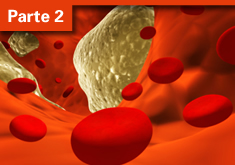Infarto de miocardio: riesgo de las lesiones coronarias no obstructivas

Referencias
1. Patel MR, Peterson ED, Dai D, et al. Low diagnostic yield of elective coronary angiography. N Engl J Med. 2010; 362(10):886-895.
2. Bugiardini R, Bairey Merz CN. Angina with “normal” coronary arteries: a changing philosophy. JAMA. 2005; 293(4):477-484.
3. Patel MR, Chen AY, Peterson ED, et al. Prevalence, predictors, and outcomes of patients with non-ST-segment elevation myocardial infarction and insignificant coronary artery disease: results from the Can Rapid risk stratification of Unstable angina patients Suppress Adverse outcomes with Early implementation of the ACC/AHA Guidelines (CRUSADE) initiative. Am Heart J. 2006; 152(4):641-647.
4. Roe MT, Harrington RA, Prosper DM, et al. Clinical and therapeutic profile of patients presenting with acute coronary syndromes who do not have significant coronary artery disease: the Platelet Glycoprotein IIb/IIIa in Unstable Angina: Receptor Suppression Using Integrilin Therapy (PURSUIT) Trial Investigators. Circulation. 2000; 102(10):1101-1106.
5. HungM-J, CherngW-J. Comparison of white blood cell counts in acute myocardial infarction patients with significant versus insignificant coronary artery disease. Am J Cardiol. 2003; 91(11):1339-1342.
6. Wang C-H, Kuo L-T, HungM-J, CherngW-J. Coronary vasospasm as a possible cause of elevated cardiac troponin I in patients with acute coronary syndrome and insignificant coronary artery disease. Am Heart J. 2002; 144(2):275-281.
7. Libby P, Theroux P. Pathophysiology of coronary artery disease. Circulation. 2005; 111(25):3481-3488.
8. LittleWC, Constantinescu M, Applegate RJ, et al. Can coronary angiography predict the site of a subsequent myocardial infarction in patients with mild-to-moderate coronary artery disease? Circulation. 1988; 78(5 pt 1):1157-1166.
9. Falk E, Shah PK, Fuster V. Coronary plaque disruption. Circulation. 1995; 92(3):657-671.
10. Ambrose JA, Tannenbaum MA, Alexopoulos D, et al. Angiographic progression of coronary artery disease and the development of myocardial infarction. J AmColl Cardiol. 1988; 12(1):56-62.
11. Giroud D, Li JM, Urban P, Meier B, RutishauerW. Relation of the site of acute myocardial infarction to the most severe coronary arterial stenosis at prior angiography. Am J Cardiol. 1992; 69(8):729-732.
12. Fuster V. Lewis A. Conner Memorial Lecture: Mechanisms leading to myocardial infarction: insights from studies of vascular biology. Circulation. 1994; 90(4):2126-2146.
13. Shah PK. Molecular mechanisms of plaque instability. Curr Opin Lipidol. 2007; 18(5):492-499.
14. Mancini GBJ, Hartigan PM, Shaw LJ, et al. Predicting outcome in the COURAGE trial (Clinical Outcomes Utilizing Revascularization and Aggressive Drug Evaluation): coronary anatomy versus ischemia. JACC Cardiovasc Interv. 2014; 7(2):195-201.
15. Brindis RG, Fitzgerald S, Anderson HV, Shaw RE, Weintraub WS, Williams JF. The American College of Cardiology-National Cardiovascular Data Registry (ACC-NCDR): building a national clinical data repository. J AmColl Cardiol. 2001; 37(8):2240-2245.
16. Box TL, McDonellM, Helfrich CD, Jesse RL, Fihn SD, Rumsfeld JS. Strategies from a nationwide health information technology implementation: the VA CART story. J Gen Intern Med. 2010; 25(suppl 1):72-76.
17. Byrd JB, Vigen R, Plomondon ME, et al. Data quality of an electronic health record tool to support VA cardiac catheterization laboratory quality improvement: the VA Clinical Assessment, Reporting, and Tracking System for Cath Labs (CART) program. Am Heart J. 2013; 165(3):434-440.
18. Wilson RF, Marcus ML, White CW. Prediction of the physiologic significance of coronary arterial lesions by quantitative lesion geometry in patients with limited coronary artery disease. Circulation. 1987; 75(4):723-732.
19. Levine GN, Bates ER, Blankenship JC, et al. 2011 ACCF/AHA/SCAI Guideline for Percutaneous Coronary Intervention: a report of the American College of Cardiology Foundation/American Heart Association Task Force on Practice Guidelines and the Society for Cardiovascular Angiography and Interventions. J AmColl Cardiol. 2011; 58(24):e44-e122.
20. Bradley SM, Maddox TM, Stanislawski MA, et al. Normal coronary rates for elective angiography in the Veterans Affairs Healthcare System: insights from the VA CART program (Veterans Affairs Clinical Assessment Reporting and Tracking). J AmColl Cardiol. 2014; 63(5):417-426.
21. Lin DY,Wei LJ. The robust inference for the Cox proportional hazards model. J AmStat Assoc. 1989; 84(408):1074-1078. doi:10.1080/01621459.1989.10478874.
22. Assessing race and ethnicity. Center for Health Equity Research and Promotion, VA Pittsburgh Healthcare System. http://www.hsrd.research.va .gov/for_researchers/cyber_seminars/archives /763-notes.pdf. Accessed October 14, 2014.
23. Raff GL, Abidov A, Achenbach S, et al; Society of Cardiovascular Computed Tomography. SCCT guidelines for the interpretation and reporting of coronary computed tomographic angiography. J Cardiovasc Comput Tomogr. 2009; 3(2):122-136.
24. Otaki Y, Arsanjani R, Gransar H, et al. What have we learned from CONFIRM? prognostic implications from a prospective multicenter international observational cohort study of consecutive patients undergoing coronary computed tomographic angiography. J Nucl Cardiol. 2012; 19(4):787-795.
25. Lin FY, Shaw LJ, Dunning AM, et al. Mortality risk in symptomatic patients with nonobstructive coronary artery disease: a prospective 2-center study of 2,583 patients undergoing 64-detector row coronary computed tomographic angiography. J AmColl Cardiol. 2011; 58(5):510-519.
26. Jespersen L, Hvelplund A, Abildstrøm SZ, et al. Stable angina pectoris with no obstructive coronary artery disease is associated with increased risks of major adverse cardiovascular events. Eur Heart J.2012; 33(6):734-744.
27. Fihn SD, Gardin JM, Abrams J, et al. 2012 ACCF/AHA/ACP/AATS/PCNA/SCAI/STS Guideline for the diagnosis and management of patients with stable ischemic heart disease: a report of the American College of Cardiology Foundation/American Heart Association Task Force on Practice Guidelines, and the American College of Physicians, American Association for Thoracic Surgery, Preventive Cardiovascular Nurses Association, Society for Cardiovascular Angiography and Interventions, and Society of Thoracic Surgeons. J AmColl Cardiol. 2012; 60(24): e44-e164.
28. Montalescot G, Sechtem U, Achenbach S, et al; Task Force Members; ESC Committee for Practice Guidelines; Document Reviewers. 2013 ESC guidelines on the management of stable coronary artery disease: the Task Force on the management of stable coronary artery disease of the European Society of Cardiology. Eur Heart J. 2013; 34(38):2949-3003.
29. Steg PG, Greenlaw N, TenderaM, et al; Prospective Observational Longitudinal Registry of PatientsWith Stable Coronary Artery Disease (CLARIFY) Investigators. myocardial ischemia and their effect on clinical outcomes in outpatients with stable coronary artery disease: data from the international observational CLARIFY Registry. JAMA Intern Med. 2014; 174(10):1651-1659
30. Tian J, Dauerman H, Toma C, et al. Prevalence and characteristics of TCFA and degree of coronary artery stenosis: an OCT, IVUS, and angiographic study. J AmColl Cardiol. 2014; 64(7):672-680.
31. Bugiardini R, Manfrini O, De Ferrari GM. Unanswered questions for management of acute coronary syndrome: risk stratification of patients with minimal disease or normal findings on coronary angiography. Arch Intern Med. 2006; 166 (13):1391-1395.
32. Newby LK, LaPointe NM, Chen AY, et al. Long-term adherence to evidence-based secondary prevention therapies in coronary artery disease. Circulation. 2006; 113(2):203-212.
33. Segev A, Beigel R, Goitein O, et al. Non-obstructive coronary artery disease upon multi-detector computed tomography in patients presenting with acute chest pain: results of an intermediate term follow-up. Eur Heart J Cardiovasc Imaging. 2012; 13(2):169-173.
34. Min JK, Dunning A, Lin FY, et al; CONFIRM Investigators. Age- and sex-related differences in all-cause mortality risk based on coronary computed tomography angiography findings: results from the International Multicenter CONFIRM (Coronary CT Angiography Evaluation for Clinical Outcomes: An International Multicenter Registry) of 23,854 patients without known coronary artery disease. J AmColl Cardiol. 2011; 58 (8):849-860.
35. Ahmadi N, Nabavi V, Hajsadeghi F, et al. Mortality incidence of patients with non-obstructive coronary artery disease diagnosed by computed tomography angiography. Am J Cardiol. 2011; 107(1):10-16.
36. De FerrariGM, Fox KA,White JA, et al. Outcomes among non-ST-segment elevation acute coronary syndromes patients with no angiographically obstructive coronary artery disease: observations from 37,101 patients. Eur Heart J Acute Cardiovasc Care. 2014; 3(1):37-45.
37. Maddox TM, Ho PM, RoeM, Dai D, Tsai TT, Rumsfeld JS. Utilization of secondary prevention therapies in patients with nonobstructive coronary artery disease identified during cardiac catheterization: insights from the National Cardiovascular Data Registry Cath-PCI Registry. Circ Cardiovasc Qual Outcomes. 2010; 3(6):632-641.
38. Bigi R, Cortigiani L, Colombo P, Desideri A, Bax JJ, Parodi O. Prognostic and clinical correlates of angiographically diffuse non-obstructive coronary lesions. Heart. 2003; 89(9):1009-1013.
39. Sullivan DR, Marwick TH, Freedman SB. A new method of scoring coronary angiograms to reflect extent of coronary atherosclerosis and improve correlation with major risk factors. Am Heart J. 1990; 119(6):1262-1267.
40. Dwyer JP, Redfern J, Freedman SB. Low utilisation of cardiovascular risk reducing therapy in patients with acute coronary syndromes and non-obstructive coronary artery disease. Int J Cardiol. 2008; 129(3):394-398.
Comentarios
Para ver los comentarios de sus colegas o para expresar su opinión debe ingresar con su cuenta de IntraMed.

















